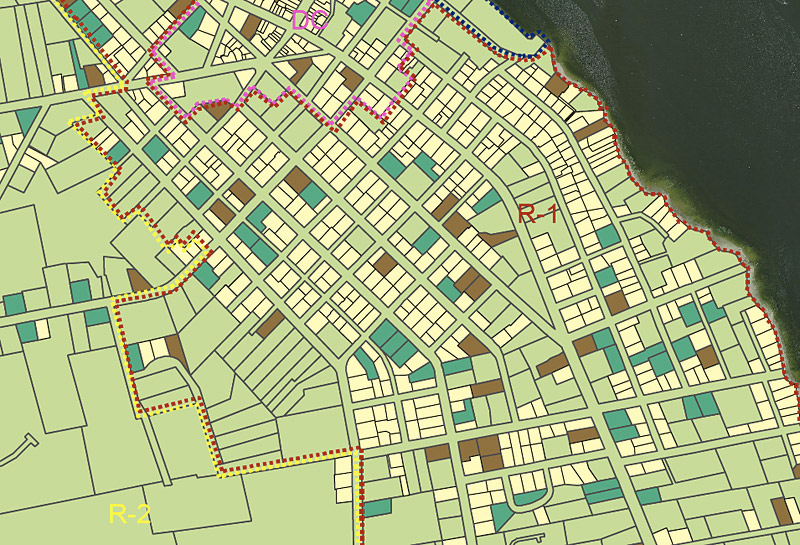Belfast Planning board divided on splitting small properties, big houses
BELFAST - Charges of social engineering and classism featured in a lively Planning Board workshop, Wednesday night. Also mentioned were Jane Jacobs’ “The Death and Life of Great American Cities” and the Soviet Union.
The hot topic? Whether to reduce the minimum lot size in a densely populated area inside the bypass from 10,000 to 7,500 square feet.
The question, along with several others considered on Wednesday, is part of a larger review of zoning ordinances intended to align property laws with goals set out in the 2009 comprehensive plan, an organic continuum of the city’s history, or some compromise between the two.
The larger revisions included a major expansion of the densely populated, in-town zoning district known as Residential 1. Changing the minimum lot size in the redrawn district would affect 51 properties. A larger number of lots in the district are currently either too small to be affected by the change or large enough that they are already eligible for subdivision.
The Planning Board mostly discussed this district on Wednesday, however similar changes would apply to the Residential 2 and Residential 3 districts.
Wayne Corey asked why Belfast, which has not seen a population increase in 20 years would change zoning to encourage subdivision of properties. Elizabeth Minor asked if the idea had come about in response to requests from property owners.
City Planner Wayne Marshall said the recommendations were based on ideas outlined in the comprehensive plan.
“If the goal is to encourage growth in growth areas,” he said, referring to zones with existing services, “This has a potential to to make that occur.”
Minor questioned the wisdom of changing the rules when there was no demand. Referring to Jane Jacobs’ treatise on urban planning, she cautioned against imposing academic planning schemes on a city where the zoning already works.
“The only thing I can think of is that someone read somewhere that this was a good idea,” she said.
Corey said changing the current zoning amounted to giving some property owners “freebies” in the form of a now-sellable subdivision of their land.
Marshall countered the current minimum lot sizes came about in the same way. “What is [sacrosanct] about 10,000 square feet?” he said. Marshall added that many properties in the Residential 1 zone could already be subdivided under the existing rules.
Minor interpreted the fact that they hadn’t as further indication that shrinking the minimum lot size was unnecessary. If the interest is not there, she argued, why change the rules?
Where Minor based her opposition partly on a lack of interest in subdividing among landowners, others looked at the issue from the perspective of a buyer.
Margot Carpenter said she had looked for vacant lots in town on several past occasions and had difficulty finding any.
Biff Atlass wagered that a market might emerge for the smaller lots in the future. The change, he said, might also allow longtime residents in danger of being priced out of their neighborhoods to stay by selling off a portion of their property.
Corey and Minor both felt that current property owners, who had made purchases and subsequent investments based on existing zoning, would be hurt if the rules were changed. Corey said he was not entirely opposed to the idea, but it didn’t sit right with his sense of how a free market system should work. Here he mentioned the Soviet Union.
“It’s not up to us to make people richer or poorer,” he said.
The history of the city was invoked in support of a variety of sometimes conflicting arguments. Marshall said the revised lot size could be seen as consistent with the numerous existing small lots that predate current zoning ordinances. Minor said the city had already been subject to inconsistent zoning imposed on neighborhoods.
Assistant City Planner Sadie Lloyd offered the example of Portland’s West End neighborhood, which had once comprised two houses but is now a thriving neighborhood.
Similarly, Belfast property lines once radiated from the bay and stretched a mile inland.
“Which history do you want to pick: when it was artificially too big, or artificially too small?” said board member Russell Barber.
Minor said the changes additionally overlooked the value of the city’s historic homes, to which Marshall hypothetically suggested an ordinance that prohibited subdividing lots of any size.
“It isn’t about square feet,” Minor said. “It’s contextual, and that’s what nobody gets.”
Chairman Paul Hamilton had a different word for it. It was “classist,” he said, to pick and choose which property owners get to do what they want. Minor disagreed.
In a straw poll, the majority of board members wanted more time to consider the proposal.
Another kind of subdivision
The topic of historic homes returned in a discussion of whether large homes should be eligible for conversion to multi-family dwellings.
The conversation came on the heels of a failed auction of the historic James P. White house (White House Inn). The landmark Greek Revival mansion had sold for $1.3 million in 2009 but didn’t get a single nod at a public sale Tuesday, despite an opening bid of $400,000.
Marshall showed the Planning Board a series of maps with the locations of dwellings ranging from 3,000 square feet to over 7,000 square feet and asked for opinions on whether any should be opened to alternate uses.
Minor noted that the larger properties were “almost without exception the most precious historical properties in Belfast.” She commended the care taken in converting the Johnson-Pratt House into Children’s Voice Preschool last year, but cautioned against the potentially slippery slope of broadly allowing alternate uses.
Several board members supported the idea of allowing conversion to condominiums, which they saw as more likely to be maintained than rental apartments.
The board also briefly considered a recommendation from Marshall that several specific properties inside the bypass be considered candidates for contract rezoning, which would allow deviations from zoning regulations subject to approval by the City Council.
Today, two properties in Belfast are governed by contract rezoning agreements: the Penobscot McCrum processing facility on Pierce Street and Front Street Shipyard.
Candidates from the new list included: Waterfall Arts (formerly Gov. Anderson School); the old hospital on High Street near Commercial Street; the former Peirce School/Belfast Academy of Music; the Alden House Inn and another property located diagonally across Church Street from the inn; the Harbor View House on Primrose Hill and others.
Marshall said he expects to present the Planning Board’s complete zoning recommendations for public review in April.
Ethan Andrews can be reached at news@penbaypilot.com






























